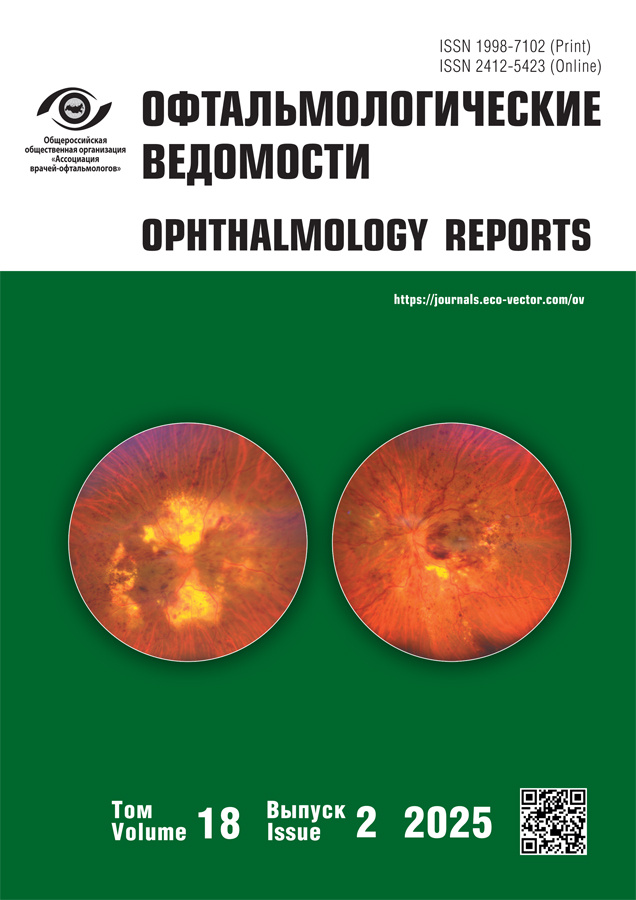Влияние слабости связочного аппарата хрусталика на рефракционные результаты факоэмульсификации
- Авторы: Белов Д.Ф.1,2, Потемкин В.В.1,3, Николаенко В.П.1,2, Рузибоева Б.О.2
-
Учреждения:
- Городская многопрофильная больница № 2
- Санкт-Петербургский государственный университет
- Первый Санкт-Петербургский государственный медицинский университет им. акад. И.П. Павлова
- Выпуск: Том 18, № 2 (2025)
- Страницы: 43-50
- Раздел: Оригинальные исследования
- Статья получена: 09.01.2025
- Статья одобрена: 30.04.2025
- Статья опубликована: 18.07.2025
- URL: https://journals.eco-vector.com/ov/article/view/645365
- DOI: https://doi.org/10.17816/OV645365
- EDN: https://elibrary.ru/NFSNIN
- ID: 645365
Цитировать
Аннотация
Обоснование. Обусловленная псевдоэксфолиативным синдромом слабость связочного аппарата хрусталика весьма распространена у жителей Северо-Западного региона России. Наряду с возрастающим риском интраоперационных осложнений слабость капсулярной поддержки может ухудшить рефракционный результат факоэмульсификации из-за воздействия на эффективную позицию линзы.
Цель — оценка влияния слабости связочного аппарата хрусталика на рефракционные результаты факоэмульсификации.
Материалы и методы. В исследование вошли 282 пациента (282 глаза), разделённые на три группы: группа 1 (контрольная) — без патологии связочного аппарата (n=109); группа 2 — пациенты с псевдоэксфолиативным синдромом (n=100); группа 3 — оперированные на фоне обусловленного псевдоэксфолиативным синдромом подвывиха хрусталика I степени, потребовавшего имплантацию капсульного кольца (n=73). Расчёт интраокулярной линзы осуществляли по формуле SRK/T. Биометрию выполняли на аппарате IOL-Master 500 (Carl Zeiss, Германия). Критерии точности расчёта интраокулярной линзы: средняя ошибка расчёта, модуль средней ошибки расчёта.
Результаты. Средняя ошибка расчёта в группах составила 0,00±0,39 дптр (группа 1), 0,12±0,50 дптр (группа 2) и 0,26±0,59 дптр (группа 3) (p=0,003), что говорит о гиперметропическом сдвиге у пациентов групп 2 и 3. Модуль средней ошибки расчёта равнялся 0,32±0,30, 0,37±0,28 и 0,52±0,45 дптр в группах соответственно (p <0,001), что, в свою очередь, свидетельствует о меньшей предсказуемости рефракционных результатов факоэмульсификации у пациентов с нестабильностью связочно-капсульного аппарата хрусталика.
Заключение. У пациентов со слабостью капсулярной поддержки наблюдается гиперметропический сдвиг, обусловленный более глубоким положением линзы в глазу после операции. Для получения оптимальных рефракционных результатов у данной категории лиц должна производиться дополнительная оптимизация а-констант интраокулярной линзы.
Полный текст
Об авторах
Дмитрий Федорович Белов
Городская многопрофильная больница № 2; Санкт-Петербургский государственный университет
Email: belovd1990@gmail.com
ORCID iD: 0000-0003-0776-4065
SPIN-код: 2380-2273
канд. мед. наук
Россия, Санкт-Петербург; Санкт-ПетербургВиталий Витальевич Потемкин
Городская многопрофильная больница № 2; Первый Санкт-Петербургский государственный медицинский университет им. акад. И.П. Павлова
Автор, ответственный за переписку.
Email: potem@inbox.ru
ORCID iD: 0000-0001-7807-9036
SPIN-код: 3132-9163
д-р мед. наук
Россия, Санкт-Петербург; Санкт-ПетербургВадим Петрович Николаенко
Городская многопрофильная больница № 2; Санкт-Петербургский государственный университет
Email: dr.Nikolaenko@mail.ru
ORCID iD: 0000-0002-6393-1289
SPIN-код: 4906-2542
д-р мед. наук
Россия, Санкт-Петербург; Санкт-ПетербургБернора Одилбек кизи Рузибоева
Санкт-Петербургский государственный университет
Email: st072295@student.spbu.ru
ORCID iD: 0009-0007-1180-6631
Россия, Санкт-Петербург
Список литературы
- Melles RB, Holladay JT, Chang WJ. Accuracy of intraocular lens calculation formulas. Ophthalmology. 2018;125(2):169–178. doi: 10.1016/j.ophtha.2017.08.027
- Belov DF, Danilenko EV, Nikolaenko VP, Potemkin VV. Evaluation of the accuracy of modern intraocular lens calculation formulas when optical biometry is not possible. Russian Annals of Ophthalmology. 2024;140(2):34–39. doi: 10.17116/oftalma202414002134 EDN: SJKQYV
- Chen Y-A, Hirnschall N, Findl O. Evaluation of 2 new optical biometry devices and comparison with the current gold standard biometer. J Cataract Refract Surg. 2011;37(3):513–517. doi: 10.1016/j.jcrs.2010.10.041
- Hoffer KJ. Accuracy of ultrasound intraocular lens calculation. Arch Ophthalmol. 1981;99(10):1819–1823. doi: 10.1001/archopht.1981.03930020693014
- Jin H, Holzer MP, Rabsilber T, et al. Intraocular lens power calculation after laser refractive surgery: corrective algorithm for corneal power estimation. J Cataract Refract Surg. 2010;36(1):87–96. doi: 10.1016/j.jcrs.2009.07.011
- Erickson P. Effects of intraocular lens position errors on postoperative refractive error. J Cataract Refract Surg. 1990;16(3):305–311. doi: 10.1016/s0886-3350(13)80699-2
- Potyomkin VV, Ageeva EV. Zonular instability in patients with pseudoexfoliative syndrome: the analysis of 1000 consecutive phacoemulsifications. Ophthalmology Reports. 2018;11(1):41–46. doi: 10.17816/OV11141-46 EDN: YVLXBA
- Hoffer KJ, Savini G. Update on intraocular lens power calculation study protocols: the better way to design and report clinical trials. Ophthalmology. 2021;128(11):115–120. doi: 10.1016/j.ophtha.2020.07.005
- Müller M, Pawlowicz K, Böhm M, et al. Impact of pseudoexfoliative syndrome on effective lens position, anterior chamber depth changes, and visual outcome after cataract surgery. Clin Ophthalmol. 2021;15:2867–2873. doi: 10.2147/OPTH.S307487
- Gür Güngör S, Akman A, Asena L, et al. Changes in anterior chamber depth after phacoemulsification in pseudoexfoliative eyes and their effect on accuracy of intraocular lens power calculation. Turk J Ophthalmol. 2016;46(6):255–258. doi: 10.4274/tjo.56659
- Vokrojová M, Havlíčková L, Brožková M, Hlinomazová Z. Effect of capsular tension ring implantation on postoperative rotational stability of a toric intraocular lens. J Refract Surg. 2020;36(3):186–192. doi: 10.3928/1081597X-20200120-01
- Kulikov AN, Danilenko EV, Dzilikhov AA. Assessment of the capsular tension ring implantation effect on the IOL position in the long term period after uncomplicated phacoemulsification. Ophthalmology in Russia. 2021;18(4):827–832. doi: 10.18008/1816-5095-2021-4-827-832 EDN: LFRIVQ
- Weber M, Hirnschall N, Rigal K, Findl O. Effect of a capsular tension ring on axial intraocular lens position. J Cataract Refract Surg. 2015;41(1):122–125. doi: 10.1016/j.jcrs.2014.04.035
- Belov DF, Nikolaenko VP. Effect of capsular tension ring implantation during phacoemulsification on postoperative refraction. Ophthalmology in Russia. 2022;19(3):489–492. doi: 10.18008/1816-5095-2022-3-489-492 EDN: BXSRKP
- Belov D, Nikolaenko V, Potemkin V. Effect of capsular tension ring implantation during phacoemulsification on postoperative refraction. Eur J Ophthalmol. 2022;32(4):2189–2193. doi: 10.1177/11206721211051920
- Belov DF, Nikolaenko VP. The influence of concomitant glaucoma on IOL power calculation accuracy. Ophthalmology Reports. 2020;13(1):5–9. doi: 10.17816/OV19025 EDN: OZOELI
- Belov DF, Nikolaenko VP. Alternative method of intraocular lens power calculation in eyes with short axial length. Russian Annals of Ophthalmology. 2022;138(3):24–28. doi: 10.17116/oftalma202213803124 EDN: WSWRBP
- Belov DF, Potemkin VV, Nikolaenko VP. Optimization of intraocular lens power calculation in pseudoexfoliation syndrome. Russian Annals of Ophthalmology. 2021;137(4):38–42. doi: 10.17116/oftalma202113704138 EDN: XMEDXT
- Chen H, Lin H, Lin Z, et al. Distribution of axial length, anterior chamber depth, and corneal curvature in an aged population in South China. BMC Ophthalmol. 2016;16(1):47. doi: 10.1186/s12886-016-0221-5
- Potyomkin VV, Goltsman EV. Cataract surgery in pseudoexfoliation syndrome. Ophthalmology Reports. 2020;13(1):37–42. doi: 10.17816/OV25739 EDN: DQZPOW
- Abulafia A, Barrett GD, Koch DD, et al. Protocols for studies of intraocular lens formula accuracy. Am J Ophthalmol. 2016;164:149–150. doi: 10.1016/j.ajo.2016.01.010
- Sanders D, Retzlaff J, Kraff M, et al. Comparison of the accuracy of the Binkhorst, Colenbrander, and SRK implant power prediction formulas. J Am Intraocul Implant Soc. 1981;7(4):337–340. doi: 10.1016/s0146-2776(81)80031-6











